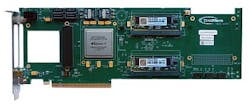FPGA embedded computing for signal processing, data acquisition offered by BittWare
FMC site support based on the VITA 57 mezzanine standard for FPGA I/O provides SerDes and LVDS, along with clocks, I2C, and JTAG connected directly to the Stratix V enabling designers to customize the S5PE-F with a variety of I/O or processor FMCs.
A new memory structure provides flexibility with two SODIMM sites that support as much as 16 gigabits of DDR3 SDRAM with optional error-correcting codes (ECC) as well as options for as much as 1 gigabytes of RLDRAM3 and as much as 72 megabytes of QDRII+.
The options for FMC I/O and memory SODIMMs combined with BittWare’s FPGA IP Libraries enhances productivity and portability and allows even greater processing efficiency.
Features include VITA 57 FMC site for I/O with full high pin count support; Altera Stratix V GX/GS; Configuration via Protocol (CvP) supported; PCI Express x8 interface supporting Gen1, Gen2, or Gen3; Four SATA connectors with speeds of 6 gigabits per second each; timestamping support; utility I/O includes USB 2.0, RS-232, and JTAG; memory options of as much as 16 gigabits of DDR3 SDRAM with ECC; as much as 1 gigabyte RLDRAM3; and as much as 72 megabytes of QDRII+.
For more information contact BittWare online at www.bittware.com.
Related stories
BittWare Anemone processor could make FPGAs as popular as general-purpose processors in embedded computing
BittWare claims new architecture puts DSP vs. FPGA debate to rest
BittWare introduces ATLANTiS FrameWork implemented in Altera FPGA to aid with designs at higher levels of abstraction.
